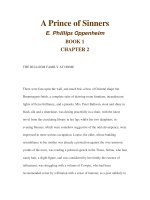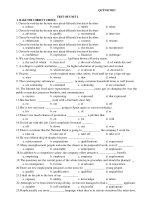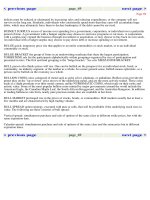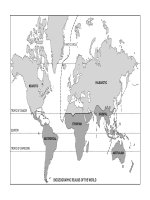Getting out of reading 2 pps
Bạn đang xem bản rút gọn của tài liệu. Xem và tải ngay bản đầy đủ của tài liệu tại đây (65.05 KB, 6 trang )
REMEMBERING WHAT YOU’VE LEARNED
91
WRITE ON!
Whatever your learning style, you’re more likely to remember what you
are learning if you write about it. (You may want to review Chapter 7,
“Knowing What You Know.”)
REWRITE
CLASS NOTES
This can make the notes easier to read—and easier for you to remember
them. This also gives you a chance to reorganize the notes so what’s
important to you will stand out. You might want to use colored markers
for certain sections.
B
EAC
OPY CAT
If you are learning something complex from a pamphlet or book, choose
a few paragraphs you feel are most important. Copy them exactly. Then
read them out loud. Copy them a second time, and then read them aloud
again. Copy a third time, read aloud a third time. If you are still feeling
challenged by the material, continue copying and reading aloud. This
really works!
WRITE AS YOU STUDY
Each time you review your reading log, class notes, or a text, you probably
see something a little differently than the time before. This is because you’re
getting more involved with what you’re learning. Write down your more
experienced viewpoints. Write how you feel about the material now, and
see the progress you make with each study session.
WRITE AFTER STUDYING
Without looking at your notes or text, write what you got out of studying
this time. Also write how you studied, how you used your learning styles.
You’ll find the more aware you are of what you do, the more likely you’ll
be successful at getting material to stick in your memory.
USING YOUR LEARNING STYLES AS YOU STUDY
IF YOU LEARN BEST BY HEARING
Read aloud (softly, if you’re around others). Also, try using a tape recorder
by recording your own notes from class and from your reading logs. Play
the tape back whenever you can, when it won’t disturb others. In a lecture
HOW TO STUDY
92
class, many instructors will permit you to bring a recorder. If you learn
best by hearing, you might find you get more out of not taking notes dur-
ing a lecture, but by focusing instead on what you’re hearing. Let your tape
recorder record the lecture so you can review it , or parts of it, later.
IF
YOU LEARN BEST BY S
EEING
Wr ite. Take notes in all classes, even when it’s a class discussion. If some-
thing unusual happens—someone had a sneezing fit and the instructor
had to stop talking—write that down, too. The unusual often helps trigger
details later. If your company or school has a film library, you might want
to see if what you’ve read about is available on film. For instance, films have
been made about how to build things, conduct science experiments, and
manage people. Many stories and novels have also been made into films.
I
F YOU
LEARN BEST
BY DOING
Role play. Act out what you’ve learned. Nobody’s watching—your character
can even be a machine, if that’s what you’re learning about. You might also
try reading and writing while walking. Some people who learn best by doing
or moving find they think more clearly when they are moving. Try it!
IF YOU LEARN BEST BY USING IMAGES
Pay attention to the “movie” in your head. Draw pictures that come to
mind in the margins of your own texts, or in your notebook.
IF YOU LEARN BEST BY USING ORDER
Make a list or chart. This can be of words, phrases, or questions. Outlines
probably come easily to you and help align your thinking as you review
old material and add new information.
(You may also want to review Chapters 2 through 5 on learning styles.
See, too, Chapters 12 through 14 on getting the most from the classroom.)
1.
2.
3.
REMEMBERING WHAT YOU’VE LEARNED
93
IN SHORT
Getting new information to stay in your memory means finding
something familiar, or unusual, in what you are learning and using your
learning style to make connections. It’s important to stop and reflect on
what you learned, and to use it as often as you can.
Practice Tip
Twenty minutes or so before you go to sleep tonight, read over (or lis-
ten to) something you want to remember. Tomorrow morning, read or
listen to the same thing again.
CHAPTER
12
GETTING THE
MOST FROM
A
LECTURE
You are “reading with
your ears” when you
listen to a lecture. To get
the most out of the
lecture, take time to
think about what
will be covered before the
speaker begins. Take
careful notes, jot down
questions that come to you,
and summarize the lecture
in your own
words afterwards.
W
hat is a lecture? Quite simply, a
lecture is a talk by one person. Lectures have been used in
the classroom since medieval times, when books were
scarce. At that time, a lecture was usually an instructor reading from the
only book available, which was usually handwritten, since the printing
press had yet to be invented. Today, sometimes lectures are read from
books or notes, but often the teacher simply speaks about a subject,
perhaps referring to a book or notes occasionally. Some teachers combine
HOW TO STUDY
96
lecture with discussion groups; some only lecture. Your job as a student in
a lecture situation is to be an active listener. You want to become involved
with what you’re hearing.
BEFORE THE LECTURE
In any class, it’s a good idea to get the phone numbers of at least two of your
classmates. Then, if you should be ill, you’ll have fellow students to call to
find out what you missed. They might let you copy their notes or their
audiotape of a lecture. If you want to study together—even if it’s over the
phone—or check information, you have potential study buddies. There’s
more to come on this in Chapter 16, “Working with a Study Buddy.”
P
REPARING FOR THE
LECTURE CLASS
Many schools and companies have lecture halls that can accommodate
fifty or more students. Seats may or may not be assigned. Before you
attend class, you can probably find out from the department or office
sponsoring the class if you may choose your seat. If so, be early! Seats up
front and along the aisles go quickly. Most lecturers permit tape
recorders, but ask for permission first. Whether you learn best by hearing
or seeing, it’s a good idea to take advantage of a tape recorder. Especially
in a large class with many distractions, it’s easy to miss something
that is said.
What’s in a Title?
You’ll probably be given the title of the lecture or the title of a reading
that the lecture is based on. Get yourself tuned up for that lecture by
playing a little guessing game beforehand:
• What do you think the lecture will be about?
• What do you know about the topic already—and what don’t you?
• How will knowing more about the subject enhance your
understanding of the class, or your knowledge in general?
Write in a notebook or record on tape whatever the title of the lec-
ture brings to mind. Write what questions you expect the lecture to
answer, based on what you think about the title. Now that you’ve guessed
what the lecture is about—you’re ready to listen!









